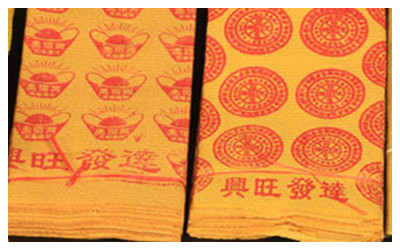Skype: neodalle-travel
Tel: +86 135 7447 2266
E-mail: sales@visitaroundchina.com

 Joss paper is traditionally made from coarse bamboo paper, although rice paper is also commonly used. Known as ghost or spirit money, Joss Paper, are sheets of paper that are burned in traditional Chinese deity or ancestor worship ceremonies during special holidays. Joss paper is also burned in traditional Chinese funerals.
Joss paper is traditionally made from coarse bamboo paper, although rice paper is also commonly used. Known as ghost or spirit money, Joss Paper, are sheets of paper that are burned in traditional Chinese deity or ancestor worship ceremonies during special holidays. Joss paper is also burned in traditional Chinese funerals.
How to use?
Traditional joss paper is cut into individual squares or rectangles. Each square of paper has either a thin piece of square foil glued to its centre or it may be endorsed with a red ink seal from a traditional Chinese seal. The colour of the paper is white, white colour representing mourning, the square foil normally has a golden or silver metal shade and hence representing wealth or money, leading to the name ghost or spirit money. Another appearance form of joss paper is "gold paper", shaped like ingots or towers.
When burning the joss paper, the sheets are treated as real money: they are not casually tossed into the fire, but instead placed respectfully in a loose bundle. Alternatively in some customs, each joss paper sheet may be folded in a specific way before being tossed into the fire. This practice is an extension of the belief that burning real money brings bad luck.
The joss paper is folded in half, or folded into a shape of a gold ingot before being burned in an earthenware pot or a specially built chimney. Joss paper burning is usually the last performed act in Chinese deity or ancestor worship ceremonies and at funerals it is the last ceremony before the deceased is lowered into the ground. In Taoist rituals, the practice of burning joss paper to deities or ancestors is acceptable.
The spirit money are a modernisation of joss paper, an afterlife monetary paper offering used in traditional Chinese ancestor veneration. The use of spirit money (also known as hell money or heaven money) in different rituals is deeply rooted in Asian culture.
 Ask Questions ?
Ask Questions ?